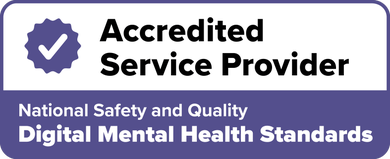Burnout vs depression: How to tell the difference?
In a Nutshell
Burnout is caused by chronic stress; depression can occur without a clear trigger and is more persistent.
Symptoms can overlap, but depression usually affects more areas of life and lasts longer.
Therapy is effective for both, although depression may need deeper psychological support.
It’s normal to have some days that feel heavier than others. But when you're no longer bouncing back like you used to, and no amount of sleep or rest seems to help, it’s hard to tell whether it’s burnout building up, or depression taking hold in a more serious way.
In this guide, we’ll walk you through the signs of burnout and depression, how they overlap, and how they differ, so you can better understand what’s going on and what steps might help you start feeling better.
If you are feeling hopeless, overwhelmed, or experiencing thoughts of suicide, please call Lifeline Australia at 13 11 14 for support. For emergencies or urgent safety concerns, call 000 immediately.
Quick glance: Burnout vs depression
Here’s a quick side-by-side comparison to help clarify the differences between burnout and depression:
Category | Burnout | Depression |
|---|---|---|
Trigger | Usually caused by chronic stress, often work-related or due to ongoing responsibilities. | Can be triggered by genetic, biological, environmental, or psychological factors. May not have a clear external cause. |
Symptoms | Mood: Irritable, detached Energy: Constant fatigue that doesn't improve with rest Behaviour: Withdrawing from work, procrastinating, relying on substances to cope | Mood: Sad, empty, hopeless Energy: Persistent tiredness or low energy Behaviour: Social withdrawal, loss of interest, possible suicidal thoughts |
Duration | Can last weeks to months. | Can last for weeks, months, or years without treatment. |
Progression | May lead to depression or anxiety if unaddressed. Can affect physical health and job performance. | May worsen over time and increase the risk of serious mental health issues if untreated. Can also affect physical health. |
Treatment | Focused on reducing stress: rest, time off, adjusting workload, self-care, therapy, and support from others. | Often involves a combination of psychotherapy, medication, lifestyle changes, and, in some cases, brain stimulation therapies. |
Recovery | Recovery often takes a few months with changes in routine and environment. | Varies depending on severity and treatment. Many people see improvement within a few months with the right care. |
In the next sections, we’ll take a closer look at what burnout and depression look like, so you can better understand what you might be experiencing.
So, what exactly is burnout?
Burnout is a state of emotional, mental and physical exhaustion that builds up over time. Burnout feels like being extremely drained and unable to bounce back when work or lifestyle stress becomes so constant and overwhelming.
While burnout is very real and deeply felt, it’s not officially recognised as a medical condition. Instead, the World Health Organization (WHO) classifies burnout as an "occupational phenomenon" that results from chronic stress that hasn’t been managed well.
But that said, chronic burnout doesn’t just affect people in traditional workplaces. It can happen to anyone, especially if you’re juggling a demanding mix of responsibilities at work or home without enough rest or support. This is also true for mothers who are facing depleted mother syndrome, which is a form of burnout from constantly caring for others.
Some obvious mental burnout symptoms include:
Cynicism, depersonalisation, or becoming detached from your job or responsibilities
Reduced performance and decreased productivity, even in tasks you once handled easily
Emotional burnout symptoms like feeling constantly drained, tired, or overwhelmed
Feeling unmotivated and anxious about going to work
Increased irritability towards coworkers or loved onesl
But there are also some less-obvious signs of burnout that can be harder to recognise as they often build up slowly or get mistaken for everyday stress or personality changes. These include:
Procrastination, like avoiding tasks more than usual due to mental fatigue
Physical symptoms of burnout like headaches, stomach issues, or sleep disturbances not linked to a physical illness
Losing your creative spark
Blunted emotions about things you used to care about
Withdrawal from coworkers or social activities
Related: Am I burnt out?
What is depression?
Depressive disorder, or depression, is a clinically recognised mental health condition defined in both the Diagnostic and Statistical Manual of Mental Disorders (DSM-5) and the International Classification of Diseases (ICD-11). It involves persistent sadness and loss of interest in most things in your life that lasts for most of the day. These feelings occur almost daily, and they usually stick for at least two weeks.
Depression can show up in different forms depending on the person and their circumstances. For example, seasonal affective Disorder (SAD) tends to appear during the darker winter months, while atypical depression may involve mood that lifts in response to positive events. Another example is postpartum depression, which is a serious and longer-lasting form of depression that can affect women after giving birth.
Regardless of the type, depression often shares some core symptoms that can significantly affect daily life. Some of the more common and recognisable signs include:
Feeling down and emptiness, or generally low mood for two weeks or more
Anhedonia or loss of interest or pleasure in things you once enjoyed
Changes in appetite or weight
Sleep disturbances like insomnia or hypersomnia
Depression, however, doesn’t always look the same in everyone. For example, depression in men is often overlooked due to social stigma and less visible symptoms. Breaking the silence around these varied experiences can help reduce shame and encourage more people to seek the support they need.
These are some subtle signs that don’t always match the typical image of depression:
Physical aches and pains without a clear medical cause
Trouble making decisions or concentrating on tasks.
Slowed thinking or movement and feeling like you're mentally or physically stuck.
Feeling needy or, conversely, isolating to avoid shame.
Temporary boost or uplift in your mood every time there’s a positive event (often seen in atypical depression)
Do I have both burnout and depression?

In some cases, a person may experience burnout and depression at once. You may be dealing with both if:
You’re emotionally exhausted
You feel sad or hopeless most of the time
You’ve lost interest not just in work, but in personal hobbies, relationships, or everyday life
Your sleep, appetite, or energy levels are noticeably off
You’re feeling irritable and overwhelmed, but also flat, numb, or worthless
You’re experiencing physical symptoms (like headaches or stomach issues) alongside emotional ones
You’ve had thoughts of not wanting to be here or feel like you can’t cope anymore
Given this overlap, it's crucial to seek professional advice from a psychologist for depression or a therapist for burnout. Misdiagnosing depression as burnout can lead to the wrong kind of support and delay proper treatment.
Not sure if it’s depression? Take this depression self-test to get a better understanding of your symptoms and their severity. Please remember that this tool isn’t a diagnosis, and it’s not a substitute for speaking with a mental health professional.
How can I start feeling better?
If you're experiencing stress or burnout, the first step is to reduce the sources that are causing you to feel that way. This might mean setting boundaries at work or taking a stress leave. Rest helps, but lasting recovery usually requires deeper changes, like seeking support through therapy.
If depression is part of the picture, treatment may need to go deeper. Evidence-based therapies like CBT (Cognitive Behavioral Therapy) or ACT (Acceptance and Commitment Therapy) have strong track records for improving mood, motivation, and functioning.
In case you’re wondering about the cost of mental health therapy in Australia, therapists usually charge around $90-$350 per session. With a Mental Health Care Plan, Medicare rebates can reduce your out-of-pocket cost to around $80-$100, or even less with bulk billing. Support is available, and often more affordable than you think.
Final thoughts
Burnout and depression can quietly wear down your energy, motivation, and sense of self, often making everyday life feel overwhelming or numb. Recognising the difference between them is a start, but healing comes from taking action. Embracing vulnerability and acknowledging that you may need support is a powerful first step.
One of the most meaningful benefits of seeing a psychologist is having a safe, non-judgmental space to explore what you're going through. Whether it’s compassion fatigue or burnout, or something deeper like depression, therapy can help you manage emotional overwhelm, rebuild your sense of balance, and take back control of your mental health.
Get Support
Overcome your burnout and book a free video consultation with one of our therapists
Essential Reading about Burnout
Burnout Therapists Available Now
VIC
Clinical Psychologist
I'm Michael, a clinical psychologist with over a decade of experience supporting children, adolescents, and adults through life's challenges. My practice is grounded in c...More
NSW
Psychologist
Hello, I am a Registered Psychologist based in New South Wales, bringing over 11 years of professional experience to my practice. I have had the privilege of supporting c...More
NT
Psychologist
Hi, Im Sean, a registered psychologist who helps adults slow down, make sense of their stress and reconnect with who they are through calm, honest, down-to-earth therapy....More








